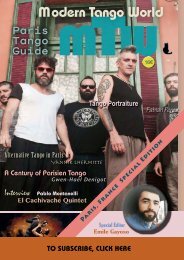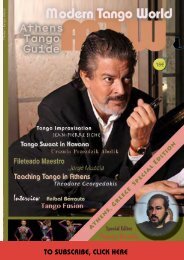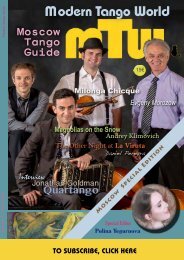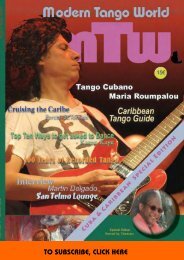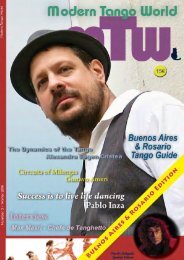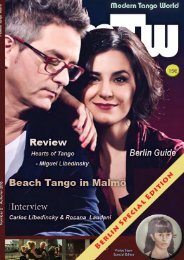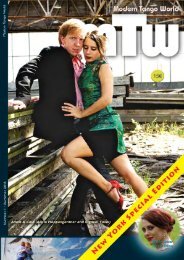Modern Tango World #4 (Bucharest, Romania)
Romania Special Features Romania’s Modern Tango Scene Dragos Samoil 3 An Act of Beauty Laura Iaru 6 Guitar Man Alexandru Eugen Cristea 12 Guide to Tango in Romania 16 The Ladies of Guardia Viejo Renato Mantioni 20 Interview with Miguel di Genova Marco Buso 24 Tango Addiction Kiran Bajaj Sawhney 28 New Tango Music Arndt Büssing 32 The Obamas Tango in Buenos Aires 38 DJ/VJ-ing - Victroleras, Tandas & Cortinas Igor Shpigelman 40 Tango Moves - Abrazos Raymond Lauzzana 44 Letters to the Editor 47
Romania Special Features
Romania’s Modern Tango Scene Dragos Samoil 3
An Act of Beauty Laura Iaru 6
Guitar Man Alexandru Eugen Cristea 12
Guide to Tango in Romania 16
The Ladies of Guardia Viejo Renato Mantioni 20
Interview with Miguel di Genova Marco Buso 24
Tango Addiction Kiran Bajaj Sawhney 28
New Tango Music Arndt Büssing 32
The Obamas Tango in Buenos Aires 38
DJ/VJ-ing - Victroleras, Tandas & Cortinas Igor Shpigelman 40
Tango Moves - Abrazos Raymond Lauzzana 44
Letters to the Editor 47
You also want an ePaper? Increase the reach of your titles
YUMPU automatically turns print PDFs into web optimized ePapers that Google loves.
Miguel Di Genova: We are currently working<br />
on a new album, which will be released almost<br />
certainly in May. In that same month we<br />
will be touring Europe. If the album will not be<br />
ready for that time, we will present some new<br />
songs from it. Then we will surely release the<br />
new album between June and July. From October<br />
to November we will be touring USA.<br />
MTW: As you said, tango is a constantly moving<br />
art form. What do you think will happen in<br />
the future? To which direction do you think it<br />
will continue its evolution?<br />
Miguel Di Genova: Looking at the past of<br />
tango, we can see a boom of tango nuevo at<br />
a certain time. That period surely produced<br />
much good music, but also poor quality music. I<br />
believe that the latter caused the recent downtrend<br />
of nuevo and the return of traditional<br />
tango. But the nature of tango is a moving one,<br />
and it always took many years to incorporate<br />
new musical forms into tradition. Regarding<br />
electrotango, I believe in the need of a change<br />
in terms, as to free it from the need to include<br />
electronica, and I predict that in five to ten<br />
years electrotango will take a different name.<br />
This could simply be tango, if electrotango will<br />
step into tradition, or neo-tango, or tango nuevo,<br />
or even twenty-first century tango, as I call it.<br />
The evolution of this twenty-first century tango will<br />
take time. It is an open musical style which requires<br />
great musical knowledge and some willingness to experiment.<br />
This evolution will be slow but steady. At<br />
some point, maybe in five years, maybe ten, maybe<br />
twenty, we will come to the point in which twentyfirst<br />
century tango will become the main music at<br />
milongas, while twentieth century tango, or traditional<br />
tango as we call it today, will turn into an important<br />
contour. Today, most milongas are traditional-styled,<br />
while just a few are nuevas. For the future I can<br />
predict an inversion of this trend. One of the main<br />
reasons for that will be a need for repopulation of<br />
tango. At the beginning of the new century, groups<br />
such as Gotan Project, Bajofondo, Narcotango had the<br />
power to attract a large number of people to tango,<br />
mainly young people. This is because such bands<br />
found proper ways to fuse tango with different musical<br />
expressions closer to todays’ general public than<br />
classical tango. We know that, generally, people like<br />
to dance to music that they like to listen to.<br />
When the nuevo impulse of these formations declined,<br />
the tango community turned back to traditional<br />
music, and a lot of neophytes lost their newfound<br />
interest. I believe that the trend will turn again<br />
to nuevo music and that the tango fever will come<br />
back, with the only difference that for that time what<br />
we now call electrotango and tango nuevo will be integrated<br />
into tango. As a result, we will not need so<br />
many terms any more. I am sure about that, but only<br />
future can tell!<br />
MTW: We can’t wait to listen to your new album,<br />
and see you back on stage and to discover what the<br />
future holds for us! Miguel, thanks for talking with us<br />
about Otros Aires’ experience and for sharing your<br />
musical and tango philosophy!<br />
— 29 —




